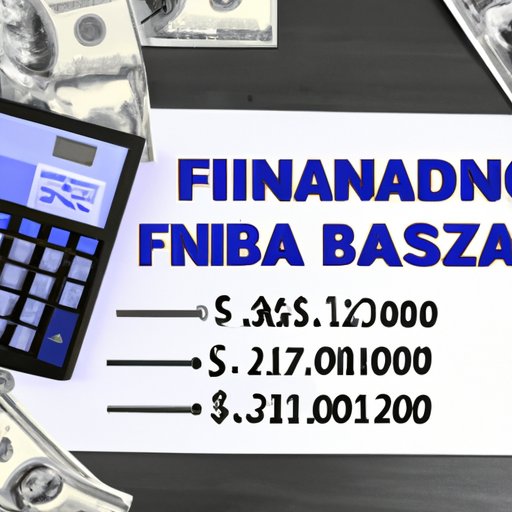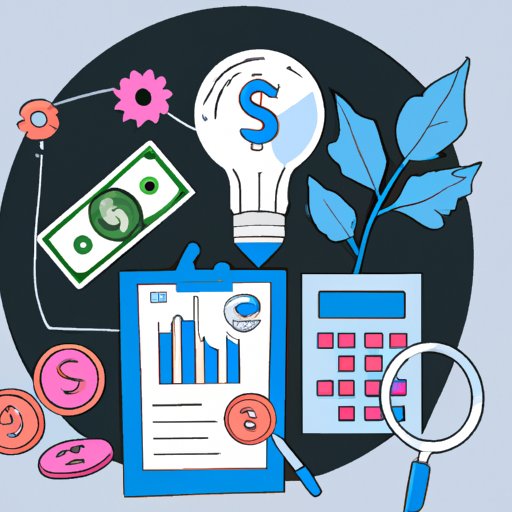Introduction
The Amazon FBA (Fulfillment by Amazon) program allows entrepreneurs to leverage the e-commerce giant’s vast network of warehouses, shipping services and customer service teams to get their products into the hands of customers quickly and cost-effectively. With minimal upfront costs and low overhead expenses, it’s easy to see why so many entrepreneurs are turning to Amazon FBA to launch their businesses.
But how much money do you need to start an Amazon FBA business? This article will provide an in-depth look at the estimated startup costs, ongoing operating expenses and investment options for launching an Amazon FBA business. We will also provide a step-by-step guide to starting an Amazon FBA business on a budget.
Calculating the Start-Up Costs of an Amazon FBA Business
When calculating the start-up costs of an Amazon FBA business, there are several factors to consider. The first is the cost of the materials and supplies needed to produce the product or products you plan to sell. This includes things like packaging materials, labels and other supplies. Depending on the type of product you’re selling, these costs can vary greatly.
In addition to materials and supplies, you’ll need to factor in the cost of shipping. This includes both the cost of shipping your products from your suppliers to Amazon’s fulfillment centers, as well as the cost of shipping your products to customers. Depending on the size and weight of your products, as well as the distance between you and your suppliers, these costs can vary significantly.
Finally, you’ll need to factor in the cost of inventory storage fees. Amazon charges a fee for storing your products in their fulfillment centers, which can range from $0.50 to $2.00 per cubic foot, depending on the size and type of product being stored. This fee can add up quickly if you’re selling large or bulky items.
A Step-by-Step Guide to Starting an Amazon FBA Business on a Budget
Once you’ve calculated the estimated start-up costs for your Amazon FBA business, you’ll need to create a budget and figure out how to make the most of your limited funds. Here’s a step-by-step guide to getting started:
1. Research Products: Before you can begin selling, you’ll need to research potential products to sell. Consider factors like demand, competition and profit margins when making your decision. You may also want to consider sourcing products from overseas suppliers to keep costs down.
2. Source Suppliers: Once you’ve identified the products you want to sell, you’ll need to find reliable suppliers. Look for suppliers that offer quality products at competitive prices, as well as those that offer flexible payment terms and quick shipping times.
3. Create a Listing: Once you’ve sourced the right suppliers, you’ll need to create a listing for each of your products on Amazon. Include detailed descriptions and high-quality images to attract customers. Also be sure to set reasonable prices based on your costs and the competition.
4. Set Up a Reasonable Pricing Structure: To maximize profits, you’ll need to set up a pricing structure that takes into account your costs as well as the current market conditions. Consider offering discounts or promotional offers to attract customers and boost sales.

How to Cut Costs When Launching an Amazon FBA Business
When starting an Amazon FBA business, it’s important to keep costs down as much as possible. Here are some tips for cutting costs while launching your business:
1. Use Low-Cost Advertising Options: Advertising is essential for driving traffic to your products, but it doesn’t have to break the bank. Consider using low-cost advertising options like Google Ads and social media marketing to reach your target audience without spending a fortune.
2. Leverage Automation Tools: There are numerous automation tools available to streamline tasks like order fulfillment, inventory management and customer service. Investing in the right automation tools can save you time and money in the long run.
3. Take Advantage of Tax Deductions: Don’t forget to take advantage of any tax deductions available for your business. This could include things like office supplies, travel expenses and business meals.
What You Need to Know About Investing in an Amazon FBA Business
Investing in an Amazon FBA business can be a great way to grow your business and generate long-term profits. But before you invest, it’s important to understand the different investment options available, assess risk vs. return and identify appropriate funding sources.
1. Understand the Different Investment Options Available: There are numerous investment options available for Amazon FBA businesses, including venture capital, angel investors, crowdfunding and more. Each option has its own advantages and disadvantages, so it’s important to research each one carefully before making a decision.
2. Assess Risk vs. Return: When investing in an Amazon FBA business, it’s important to weigh the potential risks against the potential rewards. Consider factors like the size of the investment, the expected return on investment and the amount of control you will have over the business.
3. Identify Appropriate Funding Sources: Once you’ve assessed the risks and rewards of investing in an Amazon FBA business, you’ll need to identify appropriate funding sources. Depending on the size of your business and your goals, this could include traditional lenders, venture capitalists, angel investors or other sources.
What Type of Capital Is Required to Start an Amazon FBA Business?
When starting an Amazon FBA business, you’ll need to invest both initial startup capital and ongoing operating capital. Initial startup costs include things like materials and supplies, shipping costs and inventory storage fees. Ongoing operating expenses include things like advertising, automation tools, taxes and more.

A Breakdown of the Estimated Costs of Starting an Amazon FBA Business
Overview of Startup Costs: When estimating the startup costs for an Amazon FBA business, you’ll need to factor in the cost of materials and supplies, shipping costs and inventory storage fees. Depending on the type of product you’re selling, these costs can range from a few hundred dollars to thousands of dollars.
Estimating Ongoing Operating Costs: In addition to the initial startup costs, you’ll also need to factor in ongoing operating expenses. These include things like advertising, automation tools, taxes and more. Depending on the size and scope of your business, these costs can range from a few hundred dollars to thousands of dollars per month.
Conclusion
Starting an Amazon FBA business is a great way to get your products into the hands of customers quickly and cost-effectively. However, it’s important to understand the estimated startup costs and ongoing operating expenses associated with launching an Amazon FBA business. By researching products, sourcing the right suppliers, creating a listing and setting up a reasonable pricing structure, you can launch your Amazon FBA business on a budget.
(Note: Is this article not meeting your expectations? Do you have knowledge or insights to share? Unlock new opportunities and expand your reach by joining our authors team. Click Registration to join us and share your expertise with our readers.)
